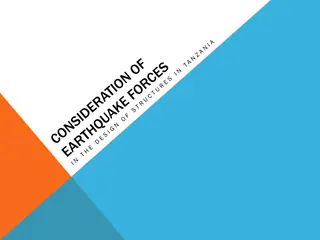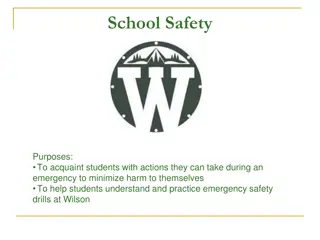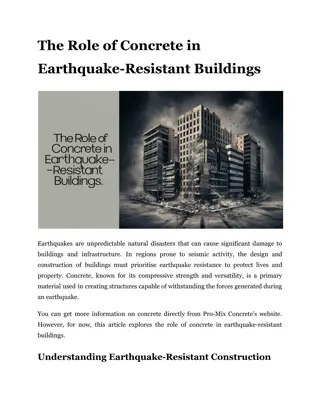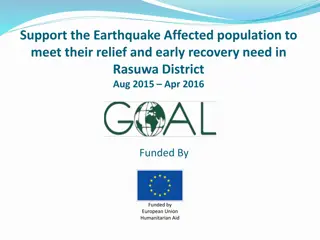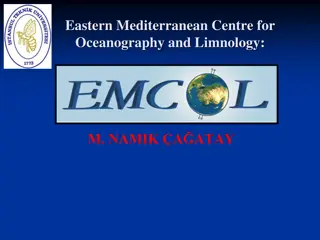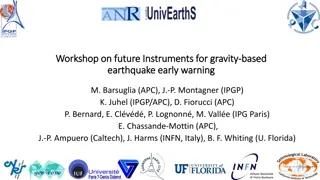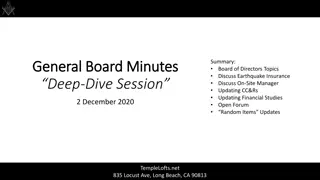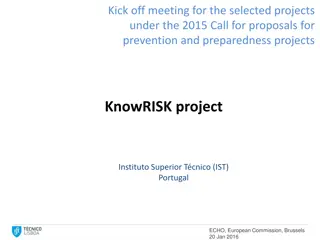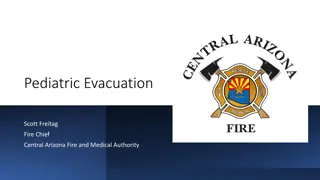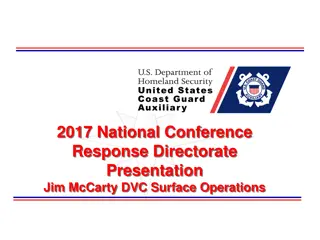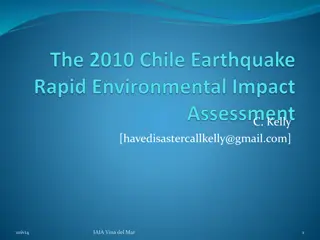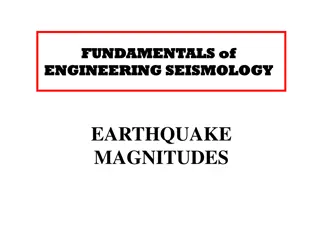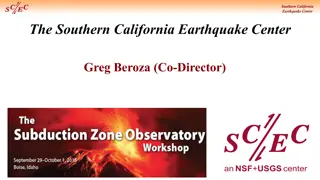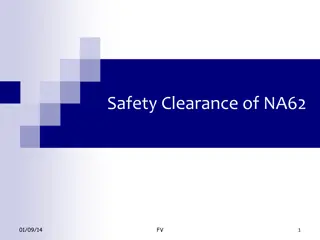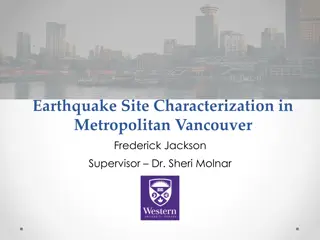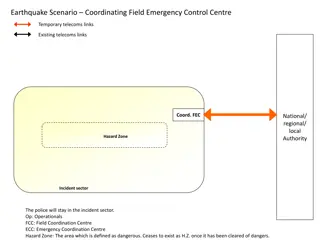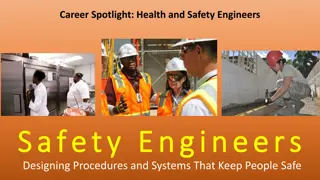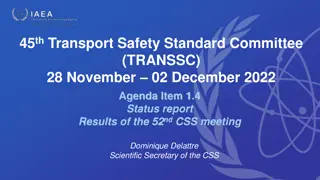FACILITY MANAGEMENT & SAFETY
Facility management and safety are interlinked disciplines crucial for optimizing workflow and ensuring a safe environment in various facilities. This includes managing space, infrastructure, resources, and staff effectively. Specific focus on laboratory facility management involves maintaining qual
3 views • 19 slides
Comprehensive Overview of CERT Basic Training and Incident Command System (ICS)
Neighborhood organizations and individuals can benefit from CERT Basic Training, learning about Disaster Preparedness, Medical Operations, Fire Safety, and more. The Incident Command System (ICS) provides a systematic approach to emergency response, emphasizing scalability and common terminology. Th
0 views • 29 slides
Safety Health and Welfare.
The Campus Safety, Health, and Welfare (SHW) Committee at TU Dublin is vital for ensuring a safe and healthy environment for all members. Led by Edel Niland, the Senior Manager, the committee focuses on various aspects such as safety arrangements, committee structure, team organization, and safety t
3 views • 21 slides
Urgent Support Needed: Nepal Earthquake Relief Efforts
A devastating 7.8 magnitude earthquake hit Nepal, causing widespread damage and leaving 2.8 million people homeless. Families are desperate for shelter as monsoon rains approach. Habitat is mobilizing engineers to assess damage, provide emergency shelter kits, and support long-term rebuilding effort
2 views • 16 slides
Earthquake Safety and Design Considerations for Building Structures
Earthquake forces can lead to structural failure in buildings, posing a risk to lives and properties. Proper planning, reinforcement, and design elements such as bracing walls and tied members are essential for ensuring safety against earthquake forces. Additionally, consideration of soil type, qual
1 views • 22 slides
Enhancing Safety: People Power SafetySTEP Refresher Training
Explore the comprehensive SafetySTEP Refresher Training program aimed at achieving safety through employee participation, engagement, and proactive safety measures. This training emphasizes creating a culture where safety is a core value, utilizing leading indicators to measure safety successes, and
0 views • 65 slides
Importance of Safety in Construction Business
Ensuring safety in construction projects is crucial for success. Safety measures should be integrated from the design phase to project completion. Key principles include having a dedicated safety department, considering safety records, allocating funds for safety management, providing safety educati
0 views • 64 slides
Comprehensive Building Safety and Emergency Preparedness Training
Enhance your safety preparedness with Building Safety Coordinator Training, Emergency Preparedness resources, Communication Resources, Fire Safety procedures, and Earthquake Safety measures. Learn about fire extinguisher use, fire response procedures, earthquake safety considerations, and the seven
1 views • 30 slides
Emergency Preparedness and Safety Drills at Wilson School
Wilson School emphasizes the importance of emergency preparedness and safety drills to ensure the well-being of students. Various drills, including fire, earthquake, lockdown, and team response, are conducted to practice necessary actions in case of emergencies. Fire drills, for instance, are crucia
0 views • 19 slides
National Mine Safety Week 2023 - Vehicle Safety Guidelines
Explore the comprehensive safety guidelines for vehicle operation during National Mine Safety Week 2023. Learn about maintaining safety equipment, cabin safety systems, visibility safety systems, operational safety systems, emergency safety systems, other safety systems, training responsibilities, a
1 views • 10 slides
Lessons Learned from Papua New Guinea's 2015-16 Drought in Dealing with the 2018 Earthquake
Exploring the correlation between the 2015-16 drought and the 2018 earthquake in Papua New Guinea offers valuable insights into disaster management strategies. Comparisons in impact, response, and long-term consequences highlight the importance of proactive measures and effective coordination in mit
0 views • 15 slides
Comparative Analysis of Aviation Safety Management Systems: MSG-3 vs. SMS
The aviation industry continuously strives to enhance safety, leading to the development of Safety Management Systems (SMS) by ICAO and the longstanding Maintenance Steering Group (MSG-3) program. These systems focus on improving safety through different approaches, with MSG-3 emphasizing engineerin
0 views • 25 slides
Ensuring Contractor Safety in Higher Education: Key Practices and Guidelines
Highlighting the importance of contractor safety in higher education, this content emphasizes the need for effective safety planning, compliance with OSHA standards, and risk mitigation strategies. It discusses serious events in higher education related to contractor safety and provides insights on
0 views • 24 slides
Optical Equipment Safety Review and Hazard Analysis
This document provides an in-depth review of the safety considerations for the ATST optical equipment, focusing on potential hazards associated with the M2 Mirror, Heat Stop Assembly, and other critical components. The Preliminary Hazard Analysis identifies various risks, causes, and recommended act
0 views • 13 slides
The Role of Concrete in Earthquake-Resistant Buildings
Discover how concrete enhances earthquake resilience in buildings. Learn key design features that make structures safer during seismic events.\n
6 views • 7 slides
Understanding Seismic Source Parameters in Earthquake Dynamics
The seismic source parameters in earthquake dynamics involve describing a fault as a discontinuity causing displacements, requiring a complex treatment of forces. The Earth's equilibrium necessitates a specific system of forces to explain displacements along faults. The seismic moment tensor, consis
4 views • 32 slides
Support for Earthquake-Affected Population in Rasuwa District, Aug 2015-Apr 2016
Support earthquake-affected population in Rasuwa District with shelter upgradation, material support, cash-for-work, livestock shed assistance, and earthquake-resistant techniques verification. Activities include distribution of shelter kits and tool kits, DRR training, mason training, construction
0 views • 13 slides
Proactive Safety Measures: PDO Safety Stand Down April 2024
A Safety Stand Down is a crucial activity to proactively discuss safety with employees, emphasizing risk awareness and injury prevention. The incident involving a fatal injury during Rig Move activities serves as a catalyst for reflection and improvement regarding safety procedures. This guide provi
1 views • 4 slides
Eastern Mediterranean Centre for Oceanography and Limnology (EMCOL): Research Focus and Facilities
EMCOL, led by M. Namik A. Atay, focuses on natural hazards, environmental changes, and earthquake risk assessment. Their research fields include earthquakes, submarine landslides, tsunamis, sea-level changes, climate change, and paleoclimatology. The center conducts fieldwork using various equipment
0 views • 13 slides
Workshop on Future Instruments for Gravity Earthquake Early Warning
Explore the cutting-edge research and developments in instruments for gravity-based early warning systems for earthquakes. Experts like M. Barsuglia, J.-P. Montagner, and K. Juhel are leading the way in this crucial field. Discover the latest projects and collaborations shaping the future of earthqu
0 views • 8 slides
Neutrino Platform Hall Access and Safety Guidelines
Guidelines for accessing and ensuring safety within the Neutrino Platform Hall at CERN, including registration, permissions, safety trainings, required equipment, online trainings, access points, and safety team responsibilities. Access is granted through registration at CERN, completion of safety t
1 views • 7 slides
Importance of Safety Education for Graduate and Undergraduate Students
Graduate and undergraduate students often lack safety knowledge and ethics, emphasizing the need for safety education over mere training. Safety education builds critical thinking, promotes safety ethics, and prepares individuals to handle future safety issues. Incorporating safety teachings through
1 views • 11 slides
Prepare and Stay Safe: A Comprehensive Guide for Earthquake Preparedness
This comprehensive guide covers various aspects of earthquake preparedness, including potential risks, necessary precautions, and steps to take during and after an earthquake. It emphasizes the importance of personal, family, and community preparedness, along with valuable insights on how to reduce
0 views • 102 slides
Board of Directors Meeting Highlights - December 2, 2020
Discussions during the Board of Directors meeting revolved around crucial topics such as Earthquake Insurance, On-Site Manager updates, CC&Rs, Financial Studies, and General Board matters. Key decisions were made regarding appointments, resignations, and handling earthquake insurance issues. The mee
0 views • 9 slides
KnowRISK Project - Kick-Off Meeting and Objectives Overview
The KnowRISK project aims to reduce seismic risks through non-structural elements in buildings. The kick-off meeting highlighted the project framework, partners, objectives, and the importance of addressing non-structural elements for earthquake resilience. Objectives include bridging the gap betwee
0 views • 10 slides
Pediatric Evacuation in Response to 7.7 Magnitude Earthquake
Central Arizona Fire and Medical Authority Fire Chief, Scott Freitag, coordinates pediatric evacuation efforts following a 7.7 magnitude earthquake in Southern California. Numerous hospitals report structural damages necessitating the evacuation of pediatric patients who require specialized care and
0 views • 19 slides
Night Surface Operations Safety Guide - Ensuring Crew Members' Safety
This presentation highlights the importance of safety in night surface operations, emphasizing the primary mission goal of ensuring all crew members return home safely. It discusses the culture of safety, emphasizing that safety is not just a program but a state of mind, attitude, and commitment. Th
0 views • 34 slides
Environmental Impact Assessment and Recovery Planning After the 2010 Chile Earthquake
The presentation discusses the Rapid Environmental Impact Assessment (REA) process conducted by a team of Chileans post the 2010 earthquake. It emphasizes the incorporation of assessment results into post-disaster recovery planning to address key issues such as disaster debris management, transition
0 views • 6 slides
NUSSC 57th Meeting - End of Term Report & Safety Standards Update
The 57th Meeting of the Nuclear Safety Standards Committee (NUSSC) concluded its 9th term with significant achievements including the approval and publication of multiple safety standards. Key highlights include the development of new standards such as SSG-3, SSG-88, SSG-89, and SSG-90 focusing on v
0 views • 8 slides
Understanding Earthquake Magnitudes and Seismic Measurements
Delve into the fundamentals of engineering seismology and earthquake magnitudes, exploring topics such as fault dimensions, slip distribution, spectral shapes, Richter's observations, and logarithmic scales. Gain insights into how seismic measurements are characterized and understand the significanc
0 views • 69 slides
Safety Practices and Reporting in Clinical Research
Safety practices and reporting in clinical research are crucial for ensuring the rights, safety, and well-being of trial subjects. This includes monitoring safety, reporting adverse events promptly, and following regulatory requirements. Investigators play a vital role in assuring subject safety and
0 views • 33 slides
Southern California Earthquake Center Overview
The Southern California Earthquake Center (SCEC) is a large consortium of institutions dedicated to coordinating earthquake research in Southern California. Their mission involves communicating earthquake understanding to reduce risk and improve community resilience, integrating information for a co
0 views • 22 slides
Safety Clearance Procedure for NA62: Overview and Recommendations
The conventional safety clearance procedure for NA62 involves checks by DGS-SEE (HSE) and obtaining radiological safety clearance from the DGS/RP group. Various safety checks are outlined in memorandums by Mark Hatch and Jonathan Gulley. Safety files for NA62 are noted to be in poor states, lacking
0 views • 8 slides
Seismic Site Characterization in Metropolitan Vancouver
The Greater Vancouver area faces high seismic risk due to its population density and critical infrastructure. Ground shaking during large earthquakes depends on various factors including the earthquake source, material properties, and site conditions. Efforts are being made to map seismic hazards, u
0 views • 13 slides
Comprehensive Earthquake Emergency Response Scenarios
This detailed content outlines various earthquake emergency response scenarios including coordinating field control centers, temporary and existing telecoms links, national/regional/local authorities' roles, hazard zones, incident sectors, and specific tasks for different emergency teams such as sea
0 views • 9 slides
Earthquake Response and Recovery Exercise Overview
This presentation outlines the objectives, goals, and purpose of a tabletop exercise focused on evaluating response and recovery efforts after an earthquake. It emphasizes educating decision-makers, defining roles, coordinating operations, sharing information, and enhancing community resilience to e
0 views • 15 slides
Innovative Earthquake Monitoring Application PDL2AQMS in Action
PDL2AQMS is a Python application designed for injecting QuakeML data into AQMS databases, supporting both Oracle and Postgres systems. Developed by a team including Ellen Yu, Mike Hagerty, and Aparna Bhaskaran, this tool enables comparison of earthquake solutions and automates association processes.
0 views • 13 slides
Digital Transformation and Dynamic Risk Management in Rail Safety by Miguel Figueres-Esteban at Renfe
Miguel Figueres-Esteban, a Telecommunications Engineer with a PhD in Psychology, leads the Digital Transformation and Training at Renfe. He is instrumental in developing a Safety Enterprise Architecture and a Safety Knowledge Graph to enhance risk management in railway safety. Renfe, under his leade
0 views • 4 slides
Exploring the Role of Safety Engineers in Ensuring Workplace Safety
Health and Safety Engineers play a crucial role in designing procedures and systems to keep people safe in various work environments. This Career Spotlight highlights the responsibilities of Safety Engineers, such as creating safety protocols and rules for workers to follow. Students are encouraged
0 views • 7 slides
Update on Safety Standards Implemented by TRANSSC
The 45th Transport Safety Standard Committee (TRANSSC) is making significant progress in endorsing and publishing safety standards for various transportation sectors. The scientific secretary, Dominique Delattre, reported on the status of endorsed safety standards, with several publications and ongo
0 views • 10 slides




